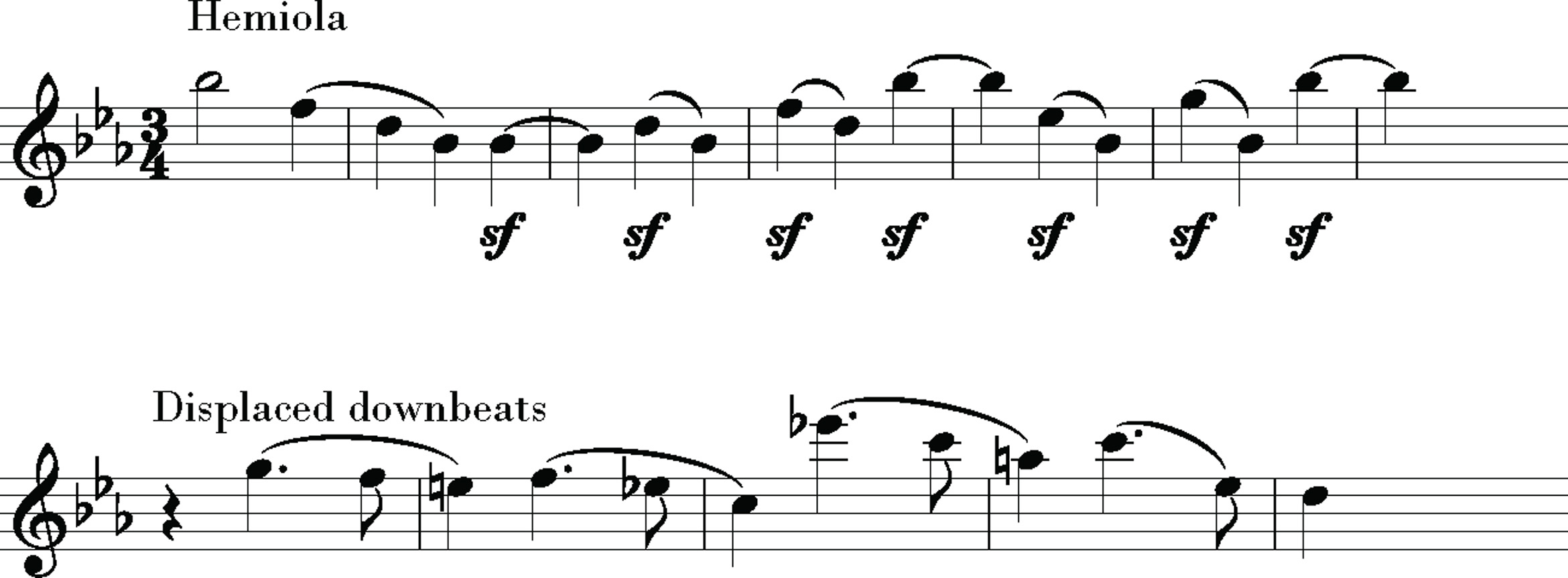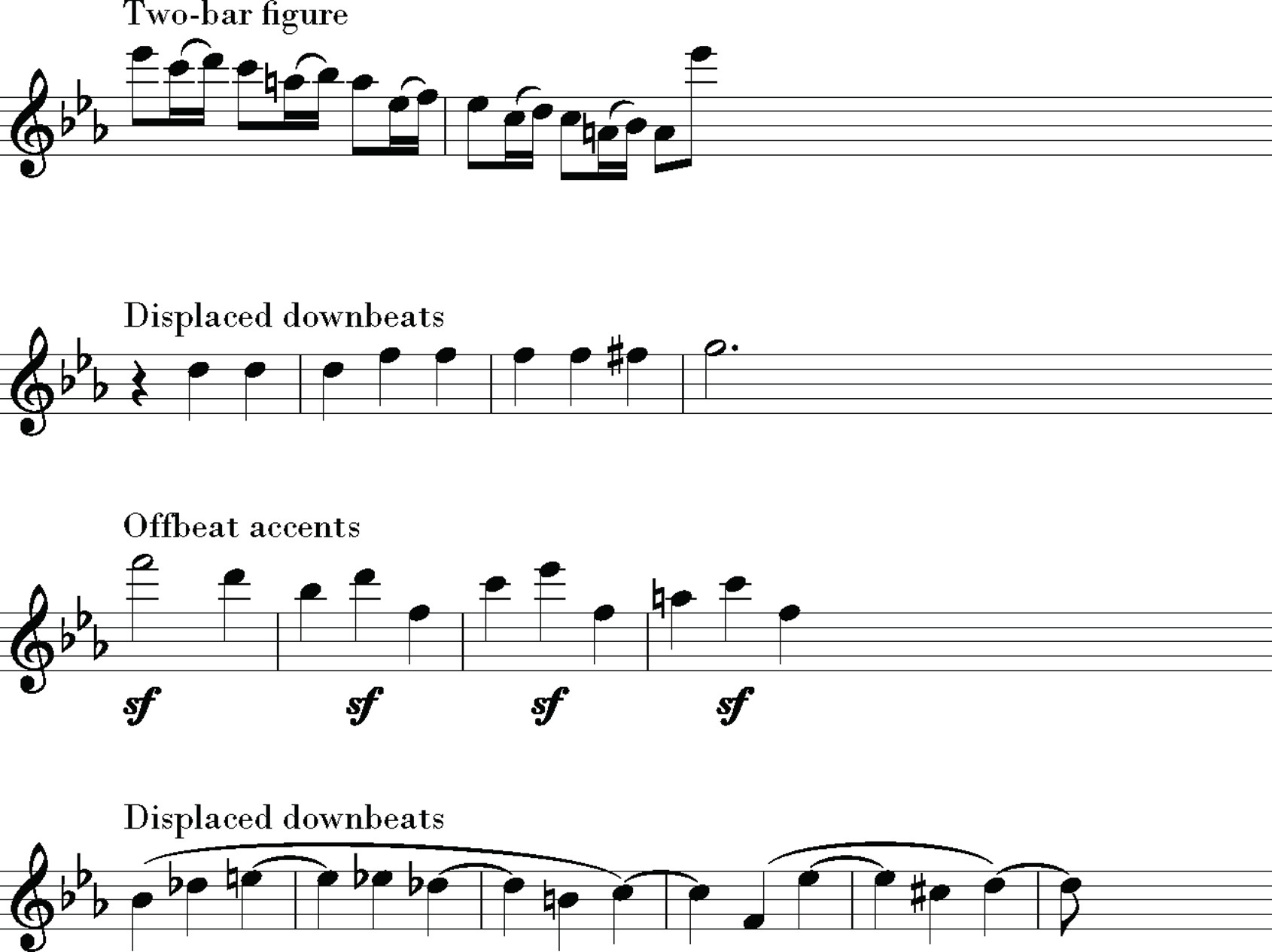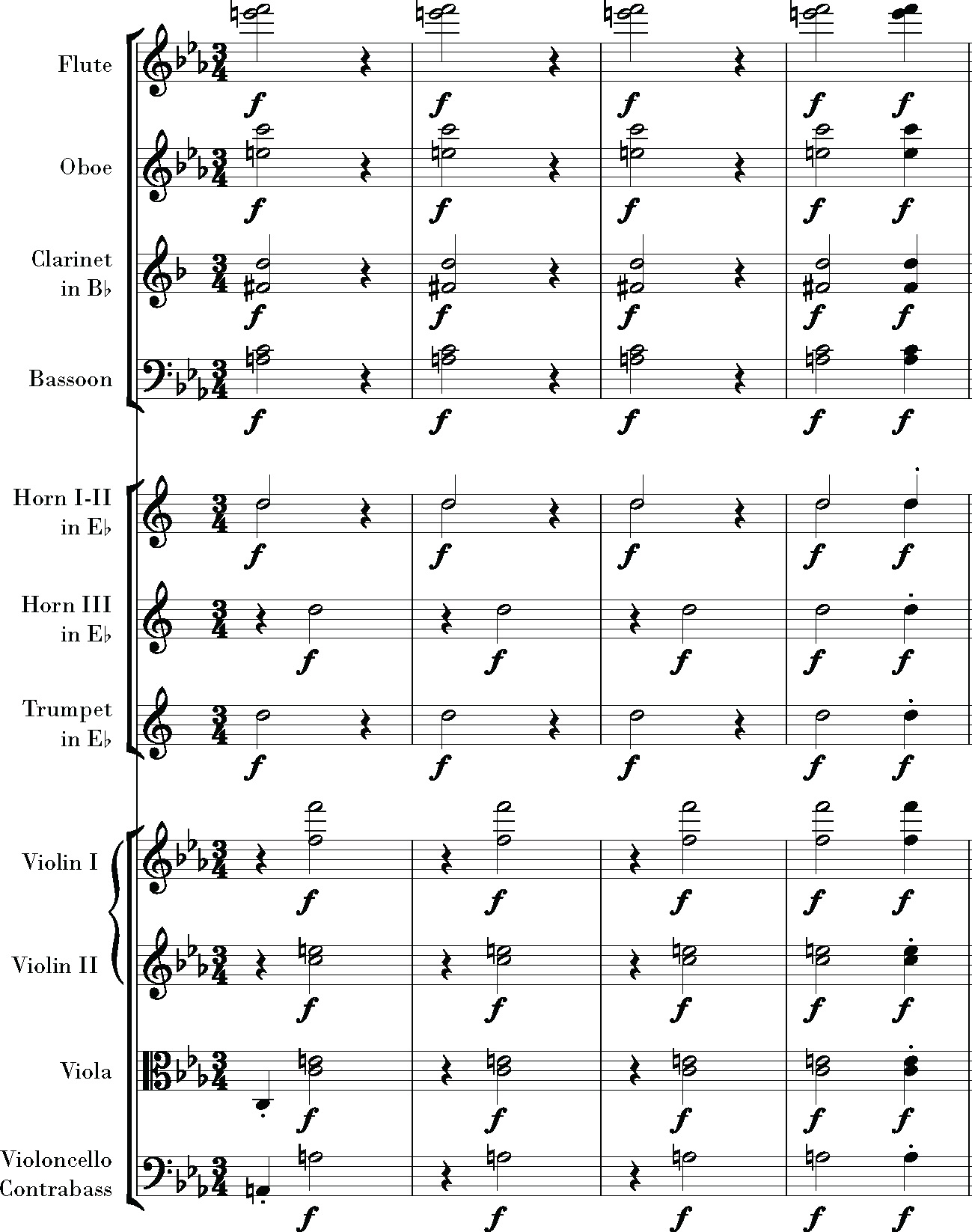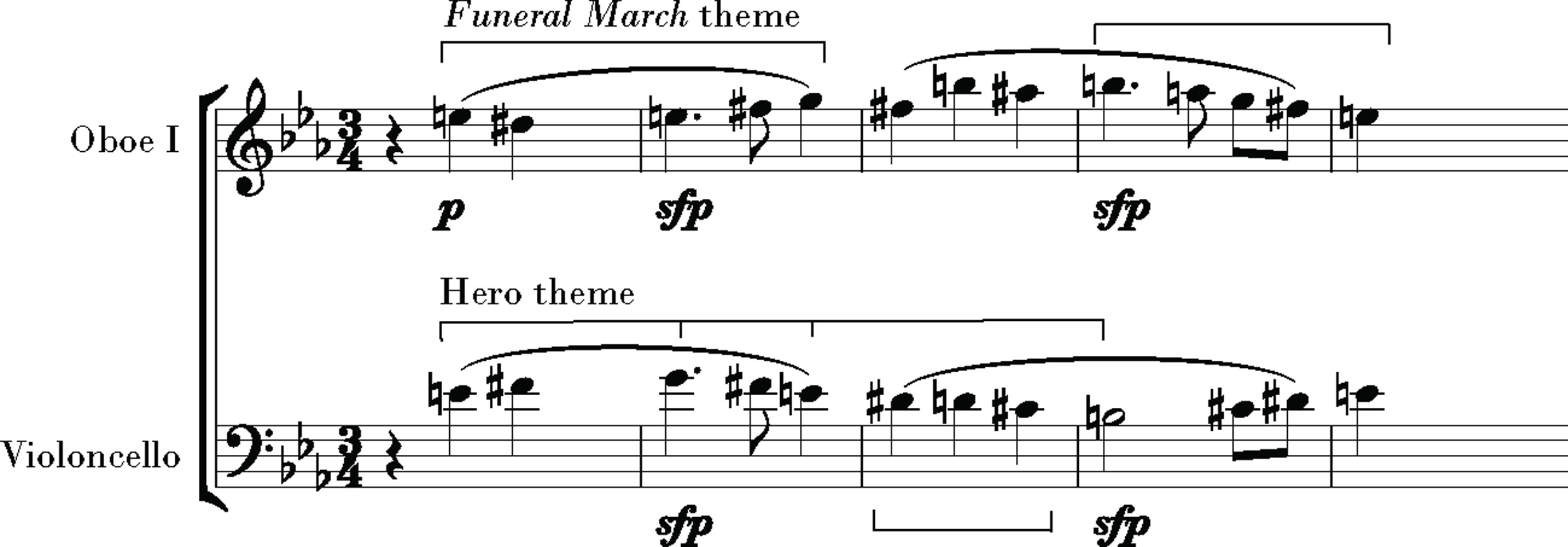Beethoven: Anguish and Triumph (56 page)

He is well into the opening movement now, forging symbol and narrative into notes and form.
20
In his primal-triad theme and its avatars in all the other themes, the Hero is a galvanizing presence, able to bring freedom because he has freed himself. As a self-created man, the Hero transcends convention, shatters barriers, electrifies every soldier and
citoyen
with the force of his will. This is the image of an enlightened leader Beethoven learned in Bonn: to remake the world, you must remake yourself first. It is the figure he celebrated in the
Joseph
Cantata and in his song from that period
Who Is a Free Man?:
“The man to whom only his own will, and not any whim of an overlord, can give laws.”
21
In sketching the exposition, he has kept his proliferating themes fluid, like the arrival of the second theme proper (measure 57). It feels tender and breathless after the perorations of the Hero theme. But the arrival of that leading secondary idea is veiled; he is more interested in flow than in eighteenth-century formal clarity. So rather than the usual clear contrast of a first and second theme, there is a welter of contrasts, flowing, pulsing, and declaiming, moving restlessly around in the meter, every moment swallowed by the relentless onwardness, the constant sense of becoming.
By the time he writes down a fourth continuity sketch of the exposition, he is close to what he is looking for.
22
As transitions the loping scales are in place. Another transition in the middle features wide leaps, which will flower later in the movement. The Hero theme is always present, either overtly in its opening triadic horn call or in the triadic scaffolding of themes that seem independent but are avatars of the Hero theme. Sections of the long drafts that are not working he takes up and revises through page after page. The end of the exposition gives him trouble. A series of sketches probes how to end the first part and usher in the
Durchführung
, the development section's quasi-improvisation on themes from the exposition.
23
Â
Like any mature artist, Beethoven understands that a splendid conception and an effective realization are different things. The struggle to realize a conception on the page is an attempt to turn productive ideas into compelling material and self-generating form: the organic, coherent, gripping play of parts and whole. In the sketchbook, he began with a narrative conception on the order of
the nature and character of the hero Napoleon, and his journey
. He has turned that idea into themes, rhythms, phrasing, orchestral colors, a singular extension of the usual sonata-form model of a first movement. In this symphony, the guidelines and signposts of that model are expanded, blurred, subverted by the working out of the conception at hand.
Bonaparte
is to be new from top to bottom, in its material and in its form, the sounding image of the free man.
As was said earlier, for a craftsman of Beethoven's level, not only melodies and harmonies are expressive and meaningful; the whole of the form is expressive and meaningful. Here ideas form and dissolve, searching for stability and completion, everything
becoming
. A characteristic gesture in the first movement is its heavy-striding hemiola passages, their two-beats contradicting the three-beat meter, breaking the bar line. The strings respond to the disorienting C-sharp on the first page with a flurry of syncopations, unsettling the rhythm; harmony and rhythm regain their footing only to drift again. All the subsidiary themes, which are variegated avatars of the Hero, break out of the boundary of the meter in one way and another, most of them by way of displaced downbeats.
Â

Â
Â

Â
Music and symbol feed on one another. In the struggle to come into his own,
the Hero shatters boundaries and conventions and makes things anew
. The exposition is as unpredictable, searching, dynamic, unstable as a development, as dynamic as a hero. In the exposition
the Hero is still uncertain, not fully formed
.
24
The task of the development proper will be to portray his struggle for completion, his triumph, his coming into his own.
Â
With the exposition largely settled, Beethoven begins to hammer out his development. One of the first ideas he writes down for it is not the beginning but the aftermath of its climax: a flowing line in the distant key of E minor, a new theme that will stand as the most sustained melody, the most themelike passage in the movement. Before he begins detailed work on the development, then, he already has in hand its goal, what will become one of the most startling and striking episodes in the movement.
25
Another early idea for the development will become the most notorious moment of all, what for more than a century will often be called an oversight, a mistake, even evidence of incipient madness. But Beethoven works out this idea through a dozen sketches, all on the same conception: while a string harmony in whispering tremolos prepares the recapitulation on a dissonance, a solo horn enters early on the Hero theme in E-flat, making an outlandish clash of harmonies:
Â

Two Beethoven Sketchbooks
Â
So before he starts working out the development in detail, he knows that its climax is going to be followed by a new theme in E minor. He also knows that the Hero theme will burst into the recapitulation prematurely, in the home key of E-flat, in its essential voice in the horn, over the wrong chord.
26
The premature
Thema
shatters the arrival of the recapitulation, as if the Hero has escaped the shackles of form and forces the music to sanction his transgression.
The Hero is a free man; it is his nature to break out of boundaries
.
As Beethoven gropes his way forward he faces a quandary: he has developed his themes from the beginning, made his exposition like a development. What, then, should he do in the development section itself? By the time he begins grappling with that problem, he has in hand the new E-minor theme and the recapitulation as targets to aim for. He settles on the idea of shaping the development as a series of waves surging toward the new theme, like armies surging toward the crux of a battle. The main element is the triadic head motif of the Hero theme rising implacably step by step in the bass, dragging the harmony upward from C minor to C-sharp, D, E, then G and A minor, and finally back to C minor. This generates a relentless, call it
fateful
, momentum different from the kaleidoscopic exposition.
For the second part of the development he feints at a fugue on a wide-striding subject that batters against the meter. But the fugue breaks down under hammer-blow hemiola chords. Those chords rise to a shattering harmony, horrifying to the ears of the timeâan evil chord, not just a climax but a catastrophe:
27
Â

Â
Following a crunching stride of dissonance in low strings, the crisis gives birth to the new theme in E minor, at the furthest remove from the home key of E-flat. This theme amounts to a new avatar of the Hero, built on his primal triad and the chromatic slideâthe latter on the same pitches but in a new context. It is the moment of triumph, when
the Hero comes into his own
.
In using the Hero theme as scaffolding for this new development theme, the most sustained melodic passage in the movement, Beethoven makes the theme integrative. It represents coming into one's own not as a cry of victory but as a matter of grace under pressure; the new theme is inward in tone, and it flows with the meter as smoothly as a waltz. It seems almost to dance away from the crisis. All the same, this theme, like all the others, is not complete. Like everything in the movement, it also drifts off, swept up in the flux.
Beethoven's sketches for the new development theme all concern what ends up as its lower voice, derived from the Hero theme. In the final version he adds a counterpoint above it. In the end the new idea becomes
a double theme
. If its lower voice is built on the scaffolding of the Hero theme, the upper voice is integrative in a different way, looking forward more than backward. In the first pages of sketching the opening movement, he has already made a first attempt at a leading idea for the
second
movement, which is to be a funeral dirge.
28
The opening phrase of the
Funeral March
theme is settled from the first sketch, because he bases it on bars 5â7 of the
Prometheus
bass. The upper voice of the new development theme in the first movement is also based on that figure. So besides being integrative in relation to the first movement,
the upper line of the new development theme foreshadows the
Thema
of the
Funeral March. And it is played by the oboe, which will be its main avatar in the
Funeral March
.
29
Â

